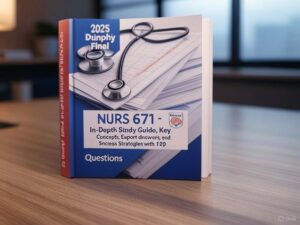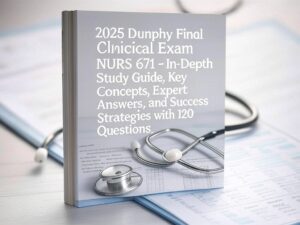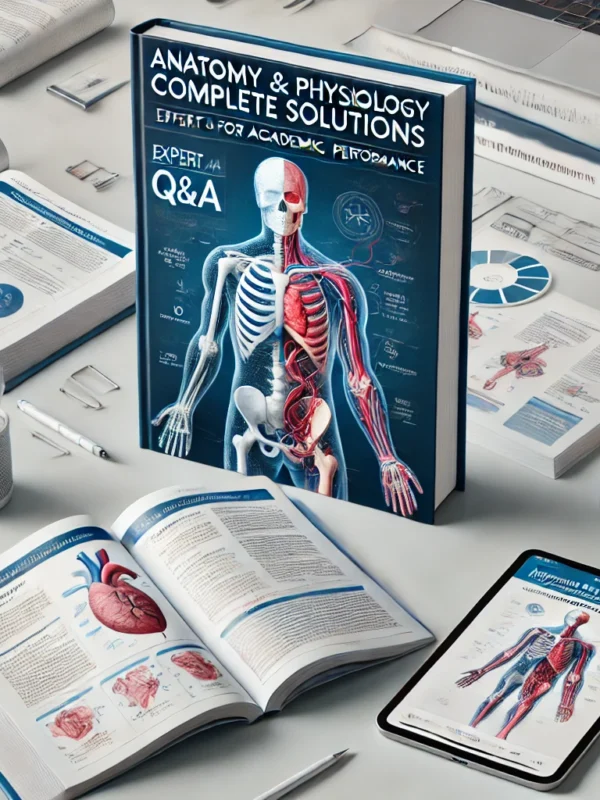Conquer the 2025 Dunphy Final Clinical Exam (NURS 671) with this detailed study guide from ExamsHut, designed for nursing students aiming for top results. This resource provides all the essentials for effective preparation.
-
120 practice questions with expert answers and in-depth explanations
-
Comprehensive coverage of key clinical concepts and patient management
-
Proven success strategies to enhance exam performance
-
Updated 2025 content aligned with NURS 671 exam standards
-
Features case studies for practical, hands-on learning
-
Expert tips to tackle complex clinical scenarios with confidence
-
Perfect for nursing students preparing for the Dunphy Final Exam
Preview
1. One of the initial steps in assessing patients with musculoskeletal complaints is
to determine whether the complaint is articular or nonarticular in origin. Which of
the following is an example of an articular structure?
a. Bone
b. Synovium
c. Tendons
d. Fascia
Correct Answer: b. Synovium
Rationale: The synovium is an articular structure that lines the joint space and
produces synovial fluid for lubrication. Articular structures are those involved in the
joint itself, including synovium, cartilage, and joint capsule.
2. You have detected the presence of crepitus on examination of a patient with a
musculoskeletal complaint. Additionally, there is limited range of motion with both
active and passive movement. These findings suggest that the origin of the
musculoskeletal complaint is:
a. Nonarticular
b. Articular
c. Tendon-related
d. Ligament-related
Correct Answer: b. Articular
Rationale: Crepitus and limited range of motion, both active and passive, are indicative
of an articular issue, suggesting that the joint itself is the source of the problem.
3. Which of the following signs or symptoms indicate an inflammatory etiology to
musculoskeletal pain?
a. Decreased CRP
b. Hyperalbuminemia
c. Morning stiffness
d. Weight gain
Correct Answer: c. Morning stiffness
Rationale: Morning stiffness is a hallmark symptom of inflammatory musculoskeletal
disorders like rheumatoid arthritis, indicating an inflammatory etiology. CRP would
typically be elevated in such cases, not decreased.
4. Which of the following statements concerning the musculoskeletal exam is true?
a. The uninvolved side should be examined initially and then compared to the involved
side.
b. The part of the body that is causing the pain should be examined first.
c. When possible, the patient should not be asked to perform active range of motion
exercises to avoid causing pain.
d. Radiographs should always be obtained prior to examination so as not to cause
further injury to the patient.
Correct Answer: a. The uninvolved side should be examined initially and then
compared to the involved side.
Rationale: It is standard practice to first examine the uninvolved side to establish a
baseline and then compare it with the involved side for differences in range of motion,
tenderness, and function.
to determine whether the complaint is articular or nonarticular in origin. Which of
the following is an example of an articular structure?
a. Bone
b. Synovium
c. Tendons
d. Fascia
Correct Answer: b. Synovium
Rationale: The synovium is an articular structure that lines the joint space and
produces synovial fluid for lubrication. Articular structures are those involved in the
joint itself, including synovium, cartilage, and joint capsule.
2. You have detected the presence of crepitus on examination of a patient with a
musculoskeletal complaint. Additionally, there is limited range of motion with both
active and passive movement. These findings suggest that the origin of the
musculoskeletal complaint is:
a. Nonarticular
b. Articular
c. Tendon-related
d. Ligament-related
Correct Answer: b. Articular
Rationale: Crepitus and limited range of motion, both active and passive, are indicative
of an articular issue, suggesting that the joint itself is the source of the problem.
3. Which of the following signs or symptoms indicate an inflammatory etiology to
musculoskeletal pain?
a. Decreased CRP
b. Hyperalbuminemia
c. Morning stiffness
d. Weight gain
Correct Answer: c. Morning stiffness
Rationale: Morning stiffness is a hallmark symptom of inflammatory musculoskeletal
disorders like rheumatoid arthritis, indicating an inflammatory etiology. CRP would
typically be elevated in such cases, not decreased.
4. Which of the following statements concerning the musculoskeletal exam is true?
a. The uninvolved side should be examined initially and then compared to the involved
side.
b. The part of the body that is causing the pain should be examined first.
c. When possible, the patient should not be asked to perform active range of motion
exercises to avoid causing pain.
d. Radiographs should always be obtained prior to examination so as not to cause
further injury to the patient.
Correct Answer: a. The uninvolved side should be examined initially and then
compared to the involved side.
Rationale: It is standard practice to first examine the uninvolved side to establish a
baseline and then compare it with the involved side for differences in range of motion,
tenderness, and function.












Reviews
There are no reviews yet.